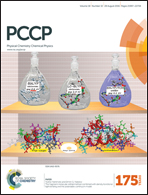Electronegativity and redox reactions†
Abstract
Using the maximum hardness principle, we show that the oxidation potential of a molecule increases as its electronegativity increases and also increases as its electronegativity in its oxidized state increases. This insight can be used to construct a linear free energy relation for the oxidation potential, which we train on a set of 31 organic redox couples and test on a set of 10 different redox reactions. Better results are obtained when the electronegativity of the oxidized/reduced reagents are adjusted to account for the reagents' interaction with their chemical environment.


 Please wait while we load your content...
Please wait while we load your content...